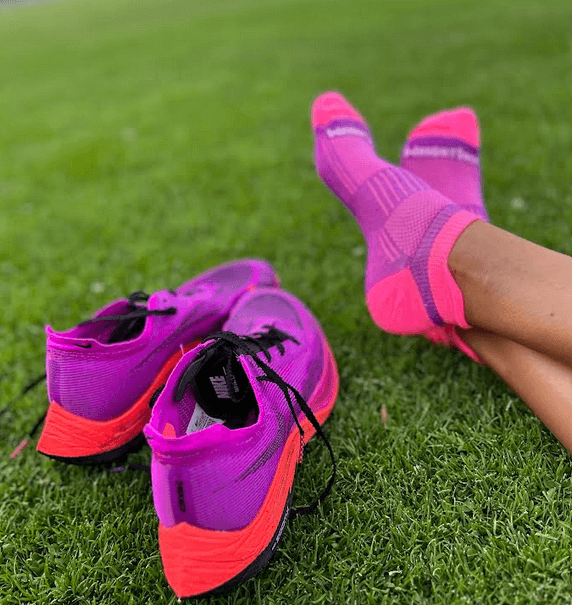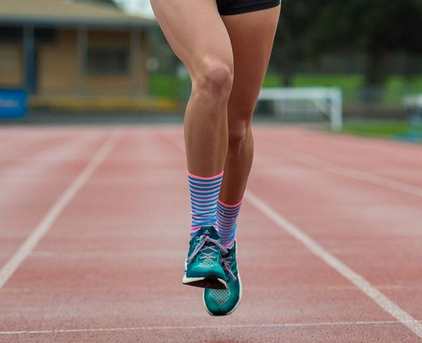Reflective Socks and Ways to Stay Safe on Runs
Running is great for your physical, mental, and emotional health, but it can also come with some danger. Due to the potential for running injuries, accidents with vehicles, and people with bad intentions, it’s a good idea to have a safety plan before you head out the door for a jog. Instead of going on a run without a plan, learn more about why running safety is important and the top nine ways to stay safe while running.
Why Is Running Safety Important When You Run Alone?
Running alone is essential for many runners who enjoy their alone time and the chance to let their minds wander while they hit the pavement. It also allows runners to stick to a pace that works for them without any need to speed up or slow down for other runners. This ability to set their own pace can also assist with safety, as lone runners won’t feel like they have to push themselves past their limit and risk an injury.
While running is a great way to stay active and enjoy some alone time, it can come with some dangers. For example, cars could accidentally hit you if they don’t see you, and injuries can occur while you’re far from home. Besides the risk of drivers and injuries, criminals sometimes target joggers. Fortunately, you can reduce these risks by taking a few precautions before you go out on a run.
9 Safety Tips for Running Alone
Despite the risks, the benefits of running alone often outweigh the potential risks for many runners. If you want to reduce these risks and maximize your safety, you’ll want to take a few precautions to protect yourself. Before your next run, review our top nine tips for safely running alone below:
1. Tell Someone Before You Go on a Run
Before you set out on a run, a good idea is to tell someone when you’re planning on starting, what your route is, and how long you expect to be running. By giving a friend, partner, or family member this information, you’ll have someone looking out for you in case you get in a potentially dangerous situation. If you don’t get back in time, someone will know where to look for you and help you faster. If your phone allows it, you can also share your location with someone you trust.
2. Bring Your Phone and ID With You
While fairly obvious, it’s important to have your ID and phone on you. During a run, injuries can happen, and having a phone with you allows you to contact someone quickly if you need help. Besides keeping your phone on you, you might also want to carry your driver’s license and a card with emergency contact information. This information could assist medical personnel and others if you’re in a situation where you’re unable to communicate clearly.
3. Switch Up Your Route
When you go on the same route every time you run, it’s more likely that someone with bad intentions notices. Instead of being an easy target, switch up your routes regularly, so you’re not predictable. Alongside reducing the chances that someone can easily find you, going on a new route will keep you more alert, as older routes tend to cause runners to zone out.
4. Only Use One Earphone
Though many runners love the sound of music or the entertainment of a podcast while out on a run, you can put yourself at risk by having both earphones in. When you tune out the world with earphones, you’ll be less aware of your surroundings. By leaving one earphone out of your ear, you’ll still be able to listen to music, but you’ll also be more aware of vehicles, animals, and other people on your route.
5. Try to Bring Someone or a Dog Along
If you want the protection that jogging with others brings but don’t want to actually run with other people, you may want to bring a dog along to run with you. A dog is a great middle-ground between running with other people versus running alone, as a dog can scare off people who might want to bother you. Plus, you won’t have to feel like you need to make conversation like you would with other joggers, and your dog will love the exercise.
6. Run Against Traffic
Unlike when you’re biking, you should always run against traffic. Though it’s best to avoid running on roads entirely, it can sometimes be unavoidable. If you do jog on the side of the road, make sure you’re running against traffic. When you run towards oncoming vehicles, you can react faster to bad drivers swerving into you.
7. Bring Pepper Spray
A recent study from Adidas found that 38% of women have experienced verbal or physical harassment while on a run, and over 50% of them have been followed, honked at, or had unwanted sexist comments or attention directed at them. Given these statistics, runners should bring pepper spray or some other self-defense device they’ve been trained to use on runs. If you’re worried about having to bring a bulky can of pepper spray with you, you should know that some brands have created compact pepper spray specifically designed for runners.
8. Consider Running in Busier Places
Just because you’re running alone doesn’t mean you shouldn’t run in busier places. While you’ll want to avoid busy roads, sticking to areas with lots of foot traffic can help a great deal. For example, if there are more people around, criminals will be less likely to try to hassle you, and if you get injured while running, you’ll have people nearby to help you. Typically, great places to run include walkable neighborhoods and city, state, or national parks.
9. Make Visibility a Priority
When you run outside, the safest times will usually be during the day, as you’ll be more visible to anyone passing by if you need help. You’ll also be more likely to avoid people with bad intentions, and drivers will have an easier time seeing you. If you choose to run at night, in the early morning, or at dusk, wear clothes with reflective colors, such as neon green, yellow, white, light blue, or orange, to make yourself more visible.
Choose Wrightsock for Anti-Blister Reflective Socks
At Wrightsock, we’re proud to offer reflective socks designed to increase a runner’s visibility. Our reflective socks feature a reflective stripe made from glass microbeads, and this stripe reflects light to make you more visible while running in low-light situations. Like our other popular anti-blister socks, our reflective socks feature a double layer designed to prevent blisters and keep your feet comfortable while you’re exercising. Besides our reflective socks, we also offer blister-free socks for numerous activities, such as running, hiking, cycling, and hunting.
Check out our anti-blister reflective socks today. If you have any questions, please feel free to contact us.




